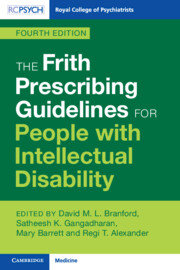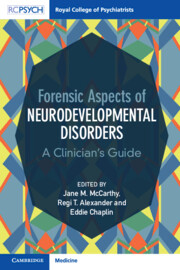21 results

The Frith Prescribing Guidelines for People with Intellectual Disability
- Coming soon
-
- Expected online publication date:
- August 2024
- Print publication:
- 31 August 2024
-
- Book
- Export citation
Index
-
- Book:
- Forensic Aspects of Neurodevelopmental Disorders
- Published online:
- 18 May 2023
- Print publication:
- 01 June 2023, pp 302-308
-
- Chapter
- Export citation
Section 3 - Criminal Justice Pathways and Legal Issues
-
- Book:
- Forensic Aspects of Neurodevelopmental Disorders
- Published online:
- 18 May 2023
- Print publication:
- 01 June 2023, pp 191-301
-
- Chapter
- Export citation
Chapter 3 - Overview of Offenders with Intellectual Disability
- from Section 1 - An Overview: Definitions, Epidemiology and Policy Issues
-
-
- Book:
- Forensic Aspects of Neurodevelopmental Disorders
- Published online:
- 18 May 2023
- Print publication:
- 01 June 2023, pp 24-33
-
- Chapter
- Export citation
Terminology Used in the Book
-
- Book:
- Forensic Aspects of Neurodevelopmental Disorders
- Published online:
- 18 May 2023
- Print publication:
- 01 June 2023, pp xv-xvi
-
- Chapter
- Export citation
Contributors
-
- Book:
- Forensic Aspects of Neurodevelopmental Disorders
- Published online:
- 18 May 2023
- Print publication:
- 01 June 2023, pp ix-xii
-
- Chapter
- Export citation
Section 2 - Assessment and Therapeutic Approach
-
- Book:
- Forensic Aspects of Neurodevelopmental Disorders
- Published online:
- 18 May 2023
- Print publication:
- 01 June 2023, pp 125-190
-
- Chapter
- Export citation
Contents
-
- Book:
- Forensic Aspects of Neurodevelopmental Disorders
- Published online:
- 18 May 2023
- Print publication:
- 01 June 2023, pp vii-viii
-
- Chapter
- Export citation
Foreword by the Rt Hon Lord Bradley
-
- Book:
- Forensic Aspects of Neurodevelopmental Disorders
- Published online:
- 18 May 2023
- Print publication:
- 01 June 2023, pp xiii-xiv
-
- Chapter
- Export citation
Chapter 1 - Introduction
- from Section 1 - An Overview: Definitions, Epidemiology and Policy Issues
-
-
- Book:
- Forensic Aspects of Neurodevelopmental Disorders
- Published online:
- 18 May 2023
- Print publication:
- 01 June 2023, pp 1-12
-
- Chapter
- Export citation
About the Cover Page
-
- Book:
- Forensic Aspects of Neurodevelopmental Disorders
- Published online:
- 18 May 2023
- Print publication:
- 01 June 2023, pp v-vi
-
- Chapter
- Export citation
Section 1 - An Overview: Definitions, Epidemiology and Policy Issues
-
- Book:
- Forensic Aspects of Neurodevelopmental Disorders
- Published online:
- 18 May 2023
- Print publication:
- 01 June 2023, pp 1-124
-
- Chapter
- Export citation
Copyright page
-
- Book:
- Forensic Aspects of Neurodevelopmental Disorders
- Published online:
- 18 May 2023
- Print publication:
- 01 June 2023, pp iv-iv
-
- Chapter
- Export citation

Forensic Aspects of Neurodevelopmental Disorders
- A Clinician's Guide
-
- Published online:
- 18 May 2023
- Print publication:
- 01 June 2023
The role of mindfulness training in sustaining weight reduction: retrospective cohort analysis
-
- Journal:
- BJPsych Open / Volume 8 / Issue 6 / November 2022
- Published online by Cambridge University Press:
- 15 November 2022, e198
-
- Article
-
- You have access
- Open access
- HTML
- Export citation
Implementing proposed reforms of the Mental Health Act for people with intellectual disability and autism: the perspective of multidisciplinary professionals in intellectual disability teams
-
- Journal:
- BJPsych Open / Volume 8 / Issue 6 / November 2022
- Published online by Cambridge University Press:
- 14 November 2022, e197
-
- Article
-
- You have access
- Open access
- HTML
- Export citation
Attention-deficit hyperactivity disorder in people with intellectual disability: statistical approach to developing a bespoke screening tool
-
- Journal:
- BJPsych Open / Volume 7 / Issue 6 / November 2021
- Published online by Cambridge University Press:
- 04 October 2021, e187
-
- Article
-
- You have access
- Open access
- HTML
- Export citation
Psychiatry and neurodevelopmental disorders: experts by experience, clinical care and research
-
- Journal:
- The British Journal of Psychiatry / Volume 218 / Issue 1 / January 2021
- Published online by Cambridge University Press:
- 28 December 2020, pp. 1-3
- Print publication:
- January 2021
-
- Article
-
- You have access
- HTML
- Export citation
Chapter 15 - Challenging Behaviour and the Use of Pharmacological Interventions
- from Section 3 - Psychiatric and Behavioural Disorders
-
-
- Book:
- Seminars in the Psychiatry of Intellectual Disability
- Published online:
- 14 January 2019
- Print publication:
- 31 January 2019, pp 179-190
-
- Chapter
- Export citation
Long-stay patients with and without intellectual disability in forensic psychiatric settings: comparison of characteristics and needs
-
- Journal:
- BJPsych Open / Volume 4 / Issue 4 / July 2018
- Published online by Cambridge University Press:
- 28 June 2018, pp. 226-234
-
- Article
-
- You have access
- Open access
- HTML
- Export citation



